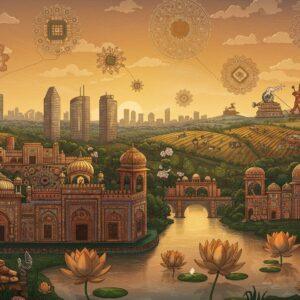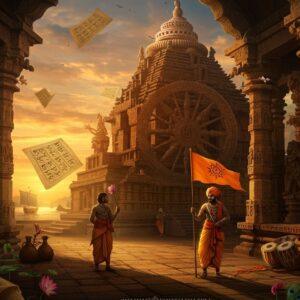
Exploring the rich heritage of India’s ancient sites brings us closer to our roots. Ellora’s Dashavatara Cave (Cave 15) is one such marvel, showcasing intricate sculptures and deep mythological significance. Located in Maharashtra, this UNESCO World Heritage Site is a must-visit for those who cherish India’s cultural tapestry and history.
Historical Context of the Dashavatara Cave
Understanding the Significance of Ellora’s Dashavatara Cave
The Dashavatara Cave holds a special place within the Ellora Caves. Commissioned by the Rashtrakuta king Dantidurga likely to commemorate his conquest of the Ellora region in the mid-8th century CE, these caves reflect the artistic and cultural influences of their time. Earlier a Buddhist monastery, the site was converted into a Shiva temple in the 8th century AD. This blend of influences is evident in the art that adorns the cave walls, offering a glimpse into the harmonious coexistence of different faiths during that era. Exploring the historical background helps us appreciate the dedication and skill involved in creating this masterpiece. The cave’s architecture and carvings tell stories of a past that values diversity and artistic expression. Understanding its history enhances our connection to the traditions that shape our cultural identity today.
Artistic Marvels of the Dashavatara Cave
Exploring the Sculptural Brilliance of Ellora’s Dashavatara Cave
The Dashavatara Cave, a jewel among the Ellora Caves, invites us into a world where art and mythology unite. The cave, rich with artistic detail, celebrates the spiritual journeys depicted in Hindu mythology.
As you step inside, you’ll find yourself surrounded by divine figures. Lord Shiva and Lord Vishnu take center stage, their forms carved with grace and power. This duality showcases the harmony between these two significant traditions, with the north side featuring predominantly Vaishnava themes, while the south and east sides are entirely Shaiva.
The ten avatars of Lord Vishnu, known as the Dashavatara, are among the most captivating features. Each avatar represents a divine intervention, a story of balance restored. The Narasimha avatar, depicted in the fierce form of a man-lion slaying Hiranyakashipu, stands out with its dynamic energy and intense expression. Other key avatars depicted include Varaha (the boar), Vamana, and representations of Govardhanadhari Vishnu, Sheshasayi Vishnu, and Vishnu on Garuda.
The bas-reliefs, featuring deities such as Ganesha, Surya, Shiva, Parvati, and Ardhanarishvara, capture moments of drama and emotion. These multi-armed figures, depicted in dynamic poses and with expressive features, embody narratives of heightened action and profound devotion. Panels near the entrance depict scenes like Markandeya-anugraha and Gangadhara, further enriching the narrative.
Mythological Narratives in the Dashavatara Cave
Connecting with Hindu Mythology Through Art
The Dashavatara Cave is a spiritual journey through time-honored myths. Each carving is a page from ancient texts, inviting exploration of Hindu philosophy and spirituality. The ten avatars of Vishnu are central to this narrative tapestry. From Matsya, the fish that saves humanity from the deluge, to Kalki, the future warrior on horseback, these avatars symbolize divine intervention in times of cosmic imbalance.
Each avatar’s story, like Varaha rescuing the Earth, carries lessons of duty, bravery, and righteousness. The cave captures not just divine battles but also moments of grace and wisdom, teaching dharma through vivid imagery. This synthesis of art and myth fosters a profound connection with India’s spiritual heritage.
Cultural and Religious Significance
Dashavatara Cave: A Living Temple of Tradition
The Dashavatara Cave is a living space where tradition thrives, particularly for devotees of Lord Vishnu. Rituals conducted here echo through generations, offering a glimpse into practices that blend devotion with cultural heritage. It inspires deeper understanding of Hindu philosophy while honoring the artistic brilliance of our ancestors.
Dashavatara Cave in the Modern Context
Preserving Heritage Amidst Modern Challenges
Preserving the Dashavatara Cave requires dedication and collaboration. Efforts aim to protect this legacy from environmental threats and modern wear. Tourism, while raising awareness, necessitates careful management. Educational initiatives promote knowledge of its historical significance, ensuring its legacy endures. Engaging with this site allows us to appreciate its beauty and importance in our shared cultural heritage.
How Poojn Helps You Honor the Dashavatara Tradition
The Dashavatara Cave showcases Lord Vishnu’s ten avatars. At Poojn.in, we help you bring this tradition home with authentic puja items for Vishnu worship:
- Complete Vishnu Puja Sets: All essential items for your puja.
- Idols of Vishnu’s Avatars: Pure copper and brass idols crafted with reverence. Explore our Radha Krishna Bigraha.
- Conch Shells (Shankh): One of Vishnu’s four main symbols, essential for traditional worship.
- Tulsi Mala and Beads: Sacred items associated with Vishnu, perfect for personal devotion. Browse our collection of spiritual beads and malas.
- Vastras (Clothing): Pure cotton garments to adorn your deities.
- Brass and Silver Lamps: Illuminate your aarti ceremonies with traditional lamps.
- Natural Incense and Dhoop: Create a sacred atmosphere with aromatic offerings.
Our products are sourced from trusted artisans, undergo quality checks, and come with detailed descriptions. We deliver across India with secure packaging. Visit www.poojn.in to explore our full range.
Embracing the Legacy of Ellora’s Dashavatara Cave
The Dashavatara Cave is a testament to Hindu mythology and artistic brilliance. It invites us to connect with timeless values. This cave is a vibrant testament to tradition. Each visit is a journey through time, offering insights into inspiring spiritual narratives. Preserving this heritage honors our ancestors and keeps alive the sacred stories. In embracing the Dashavatara Cave, we celebrate the past and the living traditions that guide us. Let us continue to engage with and preserve this legacy.
FAQs on Ellora’s Dashavatara Cave
What is the Dashavatara Cave known for?
It’s renowned for its stunning sculptures of Vishnu’s ten incarnations, offering a glimpse into Hindu mythology. These intricate carvings showcase the artistic skill of the era and provide a visual narrative of these important stories.
Where is it located?
It’s part of the Ellora Caves complex in Maharashtra, India, amongst 34 rock-cut temples and monasteries. This complex is a UNESCO World Heritage site, reflecting the rich history and cultural diversity of the region.
Why is it significant in Hindu mythology?
It beautifully depicts Vishnu’s ten avatars, each representing different aspects of the divine and holding great importance in Hindu beliefs. These stories provide moral and spiritual guidance, illustrating key concepts of dharma and cosmic balance.
What kind of art can be seen?
Visitors can admire elaborate rock-cut sculptures and reliefs, including detailed depictions of gods, goddesses, and mythological scenes. The dynamic poses and expressive features of the figures bring these stories to life.
What makes it unique compared to other Ellora Caves?
Its focus on Vishnu’s ten avatars provides a unique blend of artistic expression and mythological storytelling not as prominent in other caves. This specialization makes it a crucial site for understanding Vaishnavism within the broader context of Ellora’s religious diversity.


